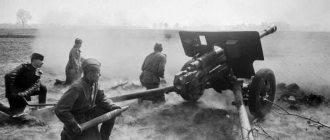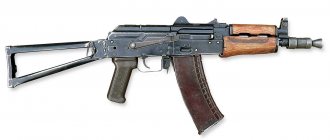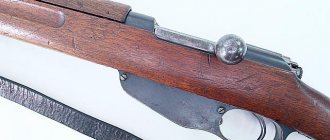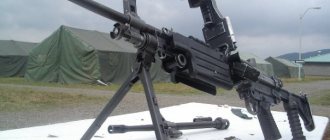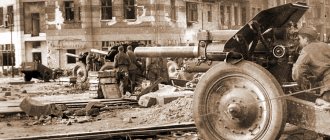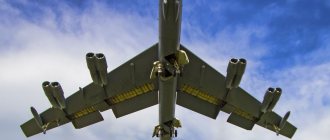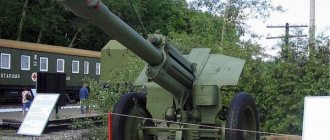| Bismarck-class battleships | |
| Performance characteristics and identification parameters of the battleship Tirpitz, published by the Department of Naval Intelligence of the US Department of the Navy | |
| Project | |
| A country |
|
| Manufacturers |
|
| Operators |
|
| Previous type | "Scharnhorst" |
| Subsequent type | type H |
| Years of construction | July 1, 1936 |
| In service | withdrawn from the fleet |
| Main characteristics | |
| Displacement | 41,700 standard, 50,900 full (Bismarck), 42,900 standard, 52,600 full (Tirpitz) |
| Length | 251 (largest), 241.5 (between perpendiculars, Bismarck), 253.6 (largest), 241.72 (between perpendiculars, Tirpitz) |
| Width | 36 |
| Draft | 8,6 — 10,6 |
| Booking | (values in [1]) • chord 320—170 • upper chord 145 • traverses 220—145 • longitudinal bulkhead 30—25 • towers GK 360—130 • barbettes GK 340—220 • towers SK 100—40 • barbettes SK 80— 20 • deck 50 - 80 + 80 - 95 (slopes 110-120) • wheelhouse 350-220 • torpedo bulkhead - 45 |
| Engines | 3 TZA, 12 PC Wagner |
| Power | 138,000 l. With. |
| Mover | 3 screws |
| Travel speed | 29 knots |
| Cruising range | 8525 miles (Bismarck), 8870 miles (Tirpitz) at 19 knots[1] |
| Crew | 2092 – 2608 people |
| Armament | |
| Artillery | 8 (4×2) - 380 mm/47 guns SK/C-34 12 × 150 mm/55 (6 × 2) |
| Flak | 8 × 2 - 105 mm/65 LC/31 (LC/37 on Tirpitz) [1], 8 × 2 - 37 mm/83, 12 × 1 - 20 mm/66 (16 × 1 on " Tirpitz")[2] |
| Aviation group | 2 catapults, 4 seaplanes |
Bismarck-class battleships
- a type of battleship (German:
Schlachtschiff
), which was in service with the Kriegsmarine during the Second World War. The most powerful battleships and the largest warships built in Germany[1].
Armament
The main caliber artillery was represented by 8 new 380-mm 47-caliber SK/C-34 guns. They could fire 800 kg shells at a range of 36.5 km, and at distances of up to 21 km their shells theoretically penetrated 350 mm armor. The division of artillery into anti-mine (150 mm) and large-caliber anti-aircraft (105 mm) artillery has been preserved. However, unlike its predecessors in the Scharnhorst type, all 150-mm guns were placed in turrets. In addition, the battleships carried a significant number of anti-aircraft gun barrels of 37 mm and 20 mm calibers. The composition of anti-aircraft weapons on the Tirpitz changed during service; in July 1944, the battleship had 78 20-mm machine guns[1]. The ships were equipped with two aviation catapults and carried up to 6 seaplanes (of which 2 were stored on catapults)[1].
Operation Title
Actually, this was not the first plan; attempts had been made before. For example, at the very end of October 1942, Operation Title entered its final phase, during which two submarine-controlled torpedoes were supposed to hit an enemy ship. A tug disguised as a trawler delivered these shells to a minimum distance, and then they followed to the target, led by special pilots who risked their lives no less than the Japanese kaiten suicide bombers.
The boat was able to penetrate into the Trondheims fjord, but the operation was unsuccessful - bad weather prevented it. A strong wave tore the torpedoes from the cable at a distance of only ten miles from the battleship. The tug had to be scuttled, the Germans discovered it a little later and understood, if not the whole plan, then at least that something was being planned against the Tirpitz.
Booking
Unlike the American battleships of the South Dakota or Iowa type, and the French types of Dunkirk and Richelieu, the main belt on the Bismarck-class battleships was external and did not have a slope. The height of the main belt was 5.2 m; it extended over 70% of the length of the ship from the bow cellars to the cellars of the aft main battery towers. Its thickness was 320, which was slightly less than that of the Scharnhorst-class ships[1]. The slabs of the main upper chord were made of Krupp KCnA cemented armor and laid on a 50 mm thick teak lining [3]. The thickness of the upper belt, on the contrary, was significantly increased compared to the Scharnhorsts - from 45 to 145. At both ends, the citadel was closed by traverses with a thickness of 145, 220 and 180 mm on the battery, main and lower decks, respectively.
The upper armor deck had a thickness of 50 mm (80 mm above the cellars), the main armor deck was 80 mm + 110 mm bevels (above the cellars 95 mm + 120 mm bevels) [1]. The deck armor was made from hardened "Wh" armor steel. The bevels enhanced protection against projectiles flying along a flat trajectory that pierced the armor belt, but weakened it against projectiles flying along an overhead trajectory at long distances, since the angle of the bevel was added to the angle of incidence of the projectile. The Germans were the only ones who still used bevels on the thick armored deck to enhance horizontal protection; this was due to the combat distances that were assumed by the Kriegsmarine.
The barbettes of the main caliber turrets were armored only above the armored deck and had a thickness of 220 mm in height to the upper deck (additional protection was provided by the side armor). Above the upper deck, the thickness of the barbette slabs increased to 340 mm. The main battery towers in the front part were protected by slabs 360 mm thick, the side parts of the towers - 150-220 mm, the back side - 320 mm. The armor for the artillery towers was made from Krupp cemented armor "KCnA"[3]. More details about the thickness of armor plates in different areas can be found in the performance characteristics table on the right. The total armor weight was 18,700 tons (44% of displacement).
We don't need war
Germany became an empire, outmaneuvering Denmark, Austria and France on the military and diplomatic fields, but Bismarck understood that his country still did not have the ability to dominate Europe. The idea of uniting all Germans in one state was never brought to life; the Habsburg Empire seriously opposed this. The “Iron Chancellor” also feared revenge from France.
Given Germany's central position in Europe and, as a consequence, the real threat of being involved in a war on two fronts, Bismarck developed a rule that he followed throughout his political career: “A strong Germany strives to live in peace and develop peacefully.”
Power plant
The power plant of the Bismarck-class battleships was three-shaft and consisted of 12 Wagner boilers (58 atm, 450°C) and 3 turbo-gear units (“Blohm und Voss” on Bismarck and “Brown-Boweri” on Tirpitz). It was characterized by low reliability and low efficiency. The actual fuel consumption exceeded the calculated one (by 10% at full speed and by 19% at economic speed on the Tirpitz cruise ship). During sea trials, the Bismarck developed 30.12 knots. (at 150,070 hp), "Tirpitz" - 30.8 knots. (at 163,026 hp)[1], fuel consumption at full speed was 0.325 kg/hp. per hour, at economic speed 0.500 kg/hp. per hour [2].
Created to rule the waves of the seven seas
Indy: German Bismarck was the largest battleship ever built. But being the biggest means being a big target.
Pair: And it was the most popular topic that you fans asked us to sing about. And we sang.
Indy: We’ll return to the song soon, but for now - the story of Bismarck.”
Indy: When Germany began building two Bismarck-class battleships in 1936, Britain was not concerned. According to the agreement, after World War I, Germany could not have warships capable of competing with the British and French. In 1935, Hitler even volunteered to limit the total tonnage of the Kriegsmarine (German Navy) to 35% of the British Navy.
Construction of a Bismarck-class battleship"
However, the launch of the first of these battleships in February 1939 showed that Hitler had violated the agreement and built something the world had never seen before. The granddaughter of Otto von Bismarck, the first chancellor of Germany, christened the ship in honor of her grandfather. The second was called Tirpitz."
Bismarck was 251 m long and 35 m wide - larger than any English or French ship. Eight 380 mm guns, arranged in pairs in four turrets, were the most powerful guns in the history of the German navy. The armament was supplemented by mine and anti-aircraft artillery, and rangefinders were the latest.
The ship was strong not only in attack. To compete with the French battleships, which seemed the most anticipated enemy in 1936, it had to be well protected. The main armor belt was 32 cm thick and was made of heavy-duty steel. The double walls of the hull absorbed and distributed the impact of the torpedo explosion. Transverse bulkheads 11-22 cm thick divided the hull into 22 compartments, each of which could be isolated during flooding. The artillery magazines and 12 high-pressure boilers were protected by additional armor 8-12 cm thick. In total, the armor accounted for 44% of the battleship's displacement, which should have made it practically unsinkable.
Service and death
Main articles: Bismarck (1939)
,
Tirpitz (1939)
Bismarck-class ships took an active part in naval combat during the Second World War. In May 1941, Bismarck, together with the heavy cruiser Prinz Eugen, participated in Operation Rheinübung (Exercise on the Rhine), a planned attack on British merchant shipping in the Atlantic. During the Battle of the Denmark Strait on May 24, 1941, he sank the British battle cruiser Hood with artillery fire, but was itself damaged by shells from the battleship Prince of Wales. During pursuit by British ships, after being hit by air torpedoes from torpedo bombers flying from the aircraft carrier Ark Royal, on May 27, 1941 he died in a battle with the British battleships Rodney and King George V and the heavy cruiser Dorsetshire 400 miles from Brest. [1].
Tirpitz is known for its operations from bases in Norway, where the ship was part of the Kriegsmarine Battle Group. During the ship's stay in Norway, it was attacked several times by naval aviation and the Air Force. On November 12, 1944, it was sunk by Lancaster bombers using super-heavy Tallboy bombs in the Tromsøfjord - as a result of two direct hits and three close explosions, it capsized and sank[1].
Situation in the Atlantic
In the spring of 1941, the German command made great efforts (not without success) to the naval blockade of the British Isles. The 24th of May became a dark date in the history of the Royal Navy. The battleship Bismarck, with well-aimed fire (perhaps accidentally), managed to destroy the cruiser Hood, the pride of the English fleet. In the battle, the German raider received damage that worsened its performance characteristics, as a result of which it was overtaken by a British squadron, fired upon, attacked by torpedoes and sunk. Success accompanied the British, but after realizing the danger that German battleships posed, they began to treat them cautiously, avoiding direct clashes, but constantly trying to destroy them.
The Germans, having lost the Bismarck, also experienced a certain stupor. For fear of losing the last dreadnought, they protected the battleship Tirpitz, hiding it in the Norwegian fjords. But weapons were created for war, and the end inevitably had to come, sooner or later.
List of ships of type[4]
| Name | Name during construction | Shipyard builder | Bookmark date | Launch date | Date of entry into the fleet | Date of withdrawal from the fleet/destruction | Fate |
| Bismarck ( "Bismarck" ) | Schlachtschiffe "F", "Ersatz Hannover"[3] | Blohm + Voss, Hamburg | 1.7.1936 | 14.2.1939 | 24.8.1940 | 27.5.1941 | Killed in battle with the British "Rodney" and "King George V" and the SRT "Dorsetshire" 400 miles from Brest |
| Tirpitz ( "Tirpitz" ) | Schlachtschiffe "G", "Ersatz Schleswig Holstein"[5] | [en.wikipedia.org/wiki/Kriegsmarinewerft_Wilhelmshaven Kriegsmarinewerft Wilhelmshaven] | 2.11.1936 | 1.4.1939 | 25.2.1941 | 12.11.1944 | Sunk by British Lancaster bombers using Tallboy super-heavy bombs in Tromsøfjord |
Sinking
On May 27, at about 9 o’clock in the morning, from a distance of 22 km, the German battleship was attacked by heavy ships from Admiral Tovey’s formation, the battleships King George the Fifth and Rodney, as well as two cruisers, Norfolk and Dorsetshire. "Bismarck" returned fire, but the pressure of the British was too massive. Half an hour later, the ship's gun turrets were badly damaged and the superstructure destroyed. It had a strong list, but stayed on the water. At 9:31 the last tower was put out of action, after which, as the surviving crew members testify, Captain Lindeman gave the order to scuttle the ship. Since the Bismarck, despite the fact that its fate was sealed, did not lower its flag, the battleship Rodney approached it at a distance of several kilometers and began to fire directly. Due to the fact that the British battleships were running low on fuel, Admiral Tovey, realizing that the Bismarck could not escape, ordered them to return to base. At approximately 10:30, the cruiser Dorsetshire fired three torpedoes at the German ship, each of which hit the target. On May 27, 1941, at 10:39, the battleship Bismarck went on board and began to sink.
Answering the question of who sank the battleship Bismarck, many recall the three decisive hits of the cruiser Dorsetshire. In fact, the ship’s fate was sealed by a hit from a torpedo bomber, which deprived it of the ability to maneuver.
The ships "Dorsetshire" and "Maori" picked up 110 people from the crew of the sunken ship. When the alarm sounded about the approach of German submarines, they hastened to leave the sinking site. In the evening, after the ships had retreated to a safe distance, the submarine U-74 rescued three more people. The next day, the hydrometeorological vessel Sachsenwald picked up two more sailors. The remaining 2,100 people died. The forces of the English fleet, which had a clear superiority at the last stage of the battle, deliberately did not save its crew when the battleship Bismarck was destroyed. In this way they avenged those killed in the sinking of the Hood.
Notes
- ↑ 123456789101112
S. V. Patyanin. Ships of the Second World War. German Navy. Part 1. - M.: “Maritime Collection”, No. 8, 2005, chapter “Battleships” - ↑ 1 2 Gröner
. Band 1. - P.58 - ↑ 123
Pechukonis N. I., Davydov Yu. V. Battleship "Bismarck" History of the ship 1934-1941 - S. V. Patyanin. Ships of the Second World War. German Navy. Part 1. - M.: “Sea Collection”, No. 8, 2005
- Gröner, p. 33
About the name
The ship was named after Alfred von Tirpitz, an outstanding figure in German politics and a prominent naval leader. The future rear admiral received the title of nobility in 1900, at the age of 50, as a reward for his many works for the benefit of his native state. He proved himself to be a prominent theorist and geopolitician by developing a plan for the reconstruction of the German Navy, which, however, did not involve its excessive expansion. At the outbreak of the First World War, the Kriegsmarine forces, in addition to other ships, had seven dreadnoughts, twenty-five cruisers, twenty battleships and four dozen submarines (about 2.5 times less than the British Navy, but enough to actively resist it) . It was on the submarines that the author of the plan had special hopes, but he was unable to convince the then German leadership that he was right. Ironically, the battleship Tirpitz also did not correspond to the late rear admiral's vision of the future of naval forces and the nature of the coming battles. It should also be noted that this extraordinary figure in every sense died in 1930, before the National Socialists came to power. Despite his militaristic beliefs (quite natural for a military man), von Tirpitz was not a fascist.
Literature
- S. V. Patyanin. Ships of the Second World War. German Navy. Part 1. - M.: “Sea Collection”, No. 8, 2005
- Pechukonis N. I., Davydov Yu. V. Battleship "Bismarck" History of the ship 1934-1941
- A. V. Platonov, Yu. V. Apalkov. German warships 1939-1945. - St. Petersburg: “Ships and Battles”, 1995
- Gröner, Erich.
Die deutschen Kriegsschiffe 1815-1945 Band 1: Panzerschiffe, Linienschiffe, Schlachschiffe, Flugzeugträger, Kreuzer, Kanonenboote. - Bernard & Graefe Verlag, 1982. - 180 p. — ISBN 978-3763748006.
Quotes[edit]
It happens to every person that he is lucky, and happiness flies very close to him
It is important to see him in time and be able to grab the hem of the clothes of fortune flying past him. — “History of Diplomacy (1940)”
See also: “100 Great Diplomats.”
| The great questions of the time are decided not by speeches and resolutions of the majority, but by iron and blood! - “Grundkurs deutsche Militärgeschichte. Die Zeit bis 1914." Im Auftrag des Militärgeschichtlichen Forschungsamtes, hrsg. von Karl-Volker Neugebauer. Oldenburg Wissensch.Vlg 2006; ISBN 978-3-486-57853-9, p. 331 |
| Nicht durch Reden oder Majoritätsbeschlüsse werden die großen Fragen der Zeit entschieden – das ist der große Fehler von 1848 und 1849 gewesen – sondern durch Eisen und Blut. |
| — Speech on September 30, 1862 in the lower house of the Landtag |
| Politics is the art of the possible. - later reprinted in Fürst Bismarck: neue Tischgespräche und Interviews (vol. 1, p. 248) |
| Die Politik ist die Lehre vom Möglichen. |
| — Interview on August 11, 1867 with Meyer von Waldeck for the newspaper “St. Petersburgische Zeitung" |
| Preventive war is suicide due to fear of death. — Quoted by Hermann Kahn as Bismarck's statement in "Thinking About the Unthinkable in the 1980s" (1984, p. 136), which was spoken in the Reichstag on February 9, 1876. Referring to March 1875, when the French National Assembly decided to increase the number his army, Bismarck asked the deputies to remember how he had told them the year before that the war must be waged in order not to be humiliated or destroyed. |
| Würden Sie da nicht sehr geneigt gewesen sein, zunächst nach dem Arzte zu schicken (Heiterkeit), um untersuchen zu lassen, wie ich dazu käme, dass ich nach meiner langen politischen Erfahrung die kolossale Dummheit begehen könnte, so vor Sie zu treten und zu sagen : Es ist möglich, dass wir in einigen Jahren einmal angegriffen werden, damit wir dem nun zuvorkommen, fallen wir rasch über unsere Nachbarn her und hauen sie zusammen, ehe sie sich vollständig erholen – gewissermaßen Selbstmord aus Besorgniß vor dem Tode . |
| All you have to do is put Germany in the saddle, and she will be able to gallop. — “Winged words: A collection of quotes from the German people.” (Geflugelte Worte: der zitatenschatz des deutschen Volkes), ISBN 3-550-08521-4, p. 375. |
| Setzen wir Deutschland, so zu sagen, in den Sattel. Reiten wird es schon können. |
| - Georg Büchmann quotes - March 11, 1867 from a speech in the Reichstag |
| Even the most successful outcome of the war will never lead to the collapse of Russia, which rests on millions of Russian believers of the Greek faith. These latter, even if they are subsequently separated by international treaties, will reconnect with each other as quickly as separated droplets of mercury find their way to each other. This is the indestructible State of the Russian nation, strong in its climate, its spaces and its unpretentiousness, as well as through the awareness of the need to constantly protect its borders. This State, even after complete defeat, will remain our creation, an enemy seeking revenge, as we have in the case of today's France in the West. — Bismarck's response to a letter from Prince Henry VII Reuss. Letter No. 349. Confidential (secret) Berlin 05/03/1888 |
| Ein derartiges Ergebnis liegt aber auch nach den glänzendsten Siegen außerhalb aller Wahrscheinlichkeit. Selbst der günstigste Ausgang des Krieges würde niemals die Zersetzung der Hauptmacht Rußlands zur Folge haben, welche auf den Millionen eigentlicher Russen griechischer Konfession beruht. Diese würden, auch wenn durch Verträge getrennt, immer sich ebenso schnell wieder zusammenfinden wie die Teile eines zerschnittenen Quecksilberkörpers. Dieses unzerstörbare Reich russischer Nation, stark durch sein Klima, seine Wüsten und seine Bedürfnislosigkeit, wie durch den Vorteil, nur eine schutzbedürftige Grenze zu haben, würde nach seiner Niederlage unser geborener und revanchebedürftiger Geg ner bleiben, genau wie das heutige Frankreich es im Westen ist. |
| I was destined by nature to become a diplomat: I was born on the first of April. — Quoted in Polish in the book “Noty i anegdoty dyplomatyczne” by Jerzy Michałowski, edited by Maria Błaszczykowa (1977), p. 35 |
| With a gentleman I will always be half more of a gentleman, with a swindler I will always be half more of a swindler. — from a conversation with Count Gyula Andrássy on September 18, 1877 |
| …avec un gentleman se suis toujours gentleman et demi, et que quand j'ai affaire à un corsaire, je tâche d'etre corsaire et demi |
Links
" Ostfriesland
"Ostfriesland Heligoland Thuringen Oldenburg Kaiser
type _"Kaiser" · "Friedrich der Grosse" · "Kaiserin" · "König Albert" · "Prince Regent Luitpold" König
type _"König" · "Grosser Kurfürst" · "Margrave" · "Kronprinz" Bayern
type _Bayern · Baden · "Saxen" ·
"Wurttemberg"type " L-20
"Kriegsmarine (German:
Kriegsmarine )Scharnhorst
type _Scharnhorst · Gneisenau Bismarck
type _"Bismarck" · "Tirpitz" type "" «H-39"/"N "" "
H-40"/"J
" "
H-41"/"K
" "
H-42"/"L
" "
H-43"/"M
" "
H-44"/"N"
»List of battleships of the German Navy unfinished ones are highlighted in italics Large surface ships Battleships Bismarck type: Bismarck • Tirpitz Scharnhorst type: Scharnhorst • Gneisenau Deutschland type (battleships): Schlesien • Schleswig-Holstein Aircraft carriers Graf Zeppelin type: Graf Zeppelin • Aircraft Carrier B De Grasse • Seydlitz (from cruiser) Heavy cruisers Deutschland type (pocket battleships): Deutschland (Lützow) • Admiral Graf Spee • Admiral Scheer Admiral Hipper type: Admiral Hipper • Blücher • Prinz Eugen • Seydlitz » • "Lutzow" Light cruisers Type "Emden": "Emden" Type "K": "Konigsberg" • "Karlsruhe" • "Cologne" Type "Leipzig": "Leipzig" • "Nuremberg" Auxiliary cruisers "Orion" • "Atlantis" • "Widder" • "Thor" • "Penguin" • "Stier" • "Komet" • "Cormoran" • "Michel" • "Coronel" • "Hansa" Destroyers Types: 1934 • 1934A • 1936 • 1936A • 1936A(Mob) • 1936B Fleets: • • • • • • Destroyers Types: 1923/Raubvogel • 1924/Raubtier • 1935 • 1937 • 1939/Elbing • 1941/“Ausland” Fleets: • • • • • • • • Torpedo boats Types S 26 • S 30 • S 38/S 38b • S 100 • S 151 • Typ 700 Fleets: • • • • • • • • • • • • • • 1 (educational) • 2 (educational) • 3 (educational) Artillery training "Bremse" • "Brummer" Submarines (list) Projects Type I • Type II • Type VII • Type IX • Type X • Type XIV • Type XVII • Type XXI • Type XXIII | Unfinished projects Fleets Combat: • • • • • • • • • • • • • • • Training: • • • • • • • • • • • • • • •
Battle of Denmark Strait
The ships "Prince of Wales" and "Hood" established visual contact with enemy ships on the morning of May 24. At about six o'clock they began to attack the German flotilla from a distance of 22 kilometers. Vice Admiral Holland, who led the British group, gave the order to fire on the first ship, as he did not know that the Bismarck had changed places with the Prinz Eugen. For some time the German side did not respond, since it was given orders to engage in battle only after the enemy entered the convoy. After several British attacks, Captain Lindemann, declaring that he would not allow his ship to be attacked with impunity, ordered return fire. Having come under fire from two German ships, Holland realized that he had made a mistake by ordering an attack on the first of them.
The sixth shot from the Prince of Wales produced a result: the shell hit the Bismarck’s fuel tanks, which caused a massive leak of fuel from the tanks and filled them with water. Soon, both German ships hit the cruiser Hood, causing severe fires on board. A few minutes later, two salvos overtook the battleship Bismarck. By that time, the enemy ships were at a distance of about 16-17 km from each other. After another hit on the Hood ship, a strong explosion was heard on it, literally tearing the ship into two halves. In a matter of minutes it was under water. Of the 1,417 crew members, only three managed to escape. The Prince of Wales continued the battle, but unsuccessfully: in order to avoid a collision with the sinking ship, he had to get closer to the enemy. Having received seven hits, the battleship left the battle using a smoke screen.
Captain Lindemann proposed to go in pursuit of the Prince of Wales and sink it, but Admiral Lutyens, due to the severe damage to the Bismarck, decided to continue the voyage to the French port of Saint-Nazaire, where the ship could be repaired and taken out into the Atlantic without hindrance. It was assumed that the ships Scharnhorst and Gneisenau would later join it. Prinz Eugen was ordered to continue shelling the British convoy on her own.
An excerpt characterizing the Bismarck-class battleships
-Are you a colonel? - shouted the chief of staff, with a German accent, in a voice familiar to Prince Andrei. - They light houses in your presence, and you stand? What does this mean? “You will answer,” shouted Berg, who was now the assistant chief of staff of the left flank of the infantry forces of the First Army, “the place is very pleasant and in plain sight, as Berg said.” Prince Andrei looked at him and, without answering, continued, turning to Alpatych: “So tell me that I’m waiting for an answer until the tenth, and if on the tenth I don’t receive news that everyone has left, I myself will have to leave everything and go to Bald Mountains.” “I, Prince, say this only because,” said Berg, recognizing Prince Andrei, “that I must carry out orders, because I always carry out them exactly... Please forgive me,” Berg made some excuses. Something crackled in the fire. The fire died down for a moment; black clouds of smoke poured out from under the roof. Something on fire also crackled terribly, and something huge fell down. - Urruru! – Echoing the collapsed ceiling of the barn, from which the smell of cakes from burnt bread emanated, the crowd roared. The flame flared up and illuminated the animatedly joyful and exhausted faces of the people standing around the fire. A man in a frieze overcoat, raising his hand, shouted: “Important!” I went to fight! Guys, it’s important!.. “It’s the owner himself,” voices were heard. “Well, well,” said Prince Andrei, turning to Alpatych, “tell me everything, as I told you.” - And, without answering a word to Berg, who fell silent next to him, he touched his horse and rode into the alley. The troops continued to retreat from Smolensk. The enemy followed them. On August 10, the regiment, commanded by Prince Andrei, passed along the high road, past the avenue leading to Bald Mountains. The heat and drought lasted for more than three weeks. Every day, curly clouds walked across the sky, occasionally blocking the sun; but in the evening it cleared again, and the sun set in a brownish-red haze. Only heavy dew at night refreshed the earth. The bread that remained on the root burned and spilled out. The swamps are dry. The cattle roared from hunger, not finding food in the sun-burnt meadows. Only at night and in the forests there was still dew and there was coolness. But along the road, along the high road along which the troops marched, even at night, even through the forests, there was no such coolness. The dew was not noticeable on the sandy dust of the road, which had been pushed up more than a quarter of an arshin. As soon as dawn broke, the movement began. The convoys and artillery walked silently along the hub, and the infantry were ankle-deep in soft, stuffy, hot dust that had not cooled down overnight. One part of this sand dust was kneaded by feet and wheels, the other rose and stood as a cloud above the army, sticking into the eyes, hair, ears, nostrils and, most importantly, into the lungs of people and animals moving along this road. The higher the sun rose, the higher the cloud of dust rose, and through this thin, hot dust one could look at the sun, not covered by clouds, with a simple eye. The sun appeared as a large crimson ball. There was no wind, and people were suffocating in this still atmosphere. People walked with scarves tied around their noses and mouths. Arriving at the village, everyone rushed to the wells. They fought for water and drank it until they were dirty. Prince Andrei commanded the regiment, and the structure of the regiment, the welfare of its people, the need to receive and give orders occupied him. The fire of Smolensk and its abandonment were an era for Prince Andrei. A new feeling of bitterness against the enemy made him forget his grief. He was entirely devoted to the affairs of his regiment, he was caring for his people and officers and affectionate with them. In the regiment they called him our prince, they were proud of him and loved him. But he was kind and meek only with his regimental soldiers, with Timokhin, etc., with completely new people and in a foreign environment, with people who could not know and understand his past; but as soon as he came across one of his former ones, from the staff, he immediately bristled again; he became angry, mocking and contemptuous. Everything that connected his memory with the past repulsed him, and therefore he tried in the relations of this former world only not to be unfair and to fulfill his duty. True, everything seemed to Prince Andrei in a dark, gloomy light - especially after they left Smolensk (which, according to his concepts, could and should have been defended) on August 6, and after his father, sick, had to flee to Moscow and throw the Bald Mountains, so beloved, built and inhabited by him, for plunder; but, despite this, thanks to the regiment, Prince Andrei could think about another subject completely independent of general issues - about his regiment. On August 10, the column in which his regiment was located reached Bald Mountains. Prince Andrey received news two days ago that his father, son and sister had left for Moscow. Although Prince Andrei had nothing to do in Bald Mountains, he, with his characteristic desire to relieve his grief, decided that he should stop by Bald Mountains. He ordered a horse to be saddled and from the transition rode on horseback to his father’s village, in which he was born and spent his childhood. Driving past a pond, where dozens of women were always talking, beating rollers and rinsing their laundry, Prince Andrei noticed that there was no one on the pond, and a torn raft, half filled with water, was floating sideways in the middle of the pond. Prince Andrei drove up to the gatehouse. There was no one at the stone entrance gate, and the door was unlocked. The garden paths were already overgrown, and calves and horses were walking around the English park. Prince Andrei drove up to the greenhouse; the glass was broken, and some trees in tubs were knocked down, some withered. He called out to Taras the gardener. Nobody responded. Walking around the greenhouse to the exhibition, he saw that the wooden carved fence was all broken and the plum fruits were torn from their branches. An old man (Prince Andrei saw him at the gate as a child) sat and weaved bast shoes on a green bench. He was deaf and did not hear Prince Andrei's entrance. He was sitting on the bench on which the old prince liked to sit, and near him was hung a stick on the branches of a broken and dried magnolia. Prince Andrei drove up to the house. Several linden trees in the old garden were cut down, one piebald horse with a foal was walking in front of the house between the rose trees. The house was boarded up with shutters. One window downstairs was open. The yard boy, seeing Prince Andrei, ran into the house. Alpatych, having sent his family away, remained alone in Bald Mountains; he sat at home and read the Lives. Having learned about the arrival of Prince Andrey, he, with glasses on his nose, buttoned up, left the house, hastily approached the prince and, without saying anything, began to cry, kissing Prince Andrey on the knee. Then he turned away with his heart at his weakness and began to report to him on the state of affairs. Everything valuable and expensive was taken to Bogucharovo. Bread, up to a hundred quarters, was also exported; hay and spring, extraordinary, as Alpatych said, this year’s harvest was taken green and mowed - by the troops. The men are ruined, some also went to Bogucharovo, a small part remains. Prince Andrei, without listening to him, asked when his father and sister left, meaning when they left for Moscow. Alpatych answered, believing that they were asking about leaving for Bogucharovo, that they left on the seventh, and again went on about the shares of the farm, asking for instructions. – Will you order the oats to be released to the teams against receipt? “We still have six hundred quarters left,” Alpatych asked. “What should I answer him? - thought Prince Andrei, looking at the old man’s bald head shining in the sun and reading in his facial expression the consciousness that he himself understood the untimeliness of these questions, but was asking only in such a way as to drown out his own grief. “Yes, let go,” he said. “If you deigned to notice disturbances in the garden,” said Alpatych, “it was impossible to prevent: three regiments passed through and spent the night, especially the dragoons.” I wrote down the rank and rank of commander to submit the petition. - Well, what are you going to do? Will you stay if the enemy takes over? – Prince Andrei asked him. Alpatych, turning his face to Prince Andrei, looked at him; and suddenly raised his hand upward with a solemn gesture. “He is my patron, his will be done!” - he said. A crowd of men and servants walked across the meadow, with their heads open, approaching Prince Andrei. - Well, goodbye! - said Prince Andrei, bending over to Alpatych. - Leave yourself, take away what you can, and they told the people to go to Ryazan or Moscow Region. – Alpatych pressed himself against his leg and began to sob. Prince Andrei carefully pushed it aside and, starting his horse, galloped down the alley. At the exhibition, still as indifferent as a fly on the face of a dear dead man, an old man sat and tapped his bast shoe, and two girls with plums in their hems, which they had picked from the greenhouse trees, ran from there and stumbled upon Prince Andrei. Seeing the young master, the eldest girl, with fear expressed on her face, grabbed her smaller friend by the hand and hid with her behind a birch tree, not having time to pick up the scattered green plums. Prince Andrei, frightened, hastily turned away from them, afraid to let them notice that he had seen them. He felt sorry for this pretty, frightened girl. He was afraid to look at her, but at the same time he had an irresistible desire to do so. A new, gratifying and calming feeling came over him when, looking at these girls, he realized the existence of other, completely alien to him and just as legitimate human interests as those that occupied him. These girls, obviously, passionately desired one thing - to carry away and eat these green plums and not be caught, and Prince Andrei wished with them the success of their enterprise. He couldn't help but look at them again. Believing themselves to be safe, they jumped out of the ambush and, squealing something in thin voices, holding their hems, ran merrily and quickly through the grass of the meadow with their tanned bare feet. Prince Andrei refreshed himself a little by leaving the dusty area of the high road along which the troops were moving. But not far beyond the Bald Mountains, he again drove onto the road and caught up with his regiment at a halt, near the dam of a small pond. It was two o'clock after noon. The sun, a red ball of dust, was unbearably hot and burned my back through my black frock coat. The dust, still the same, stood motionless above the chatter of the humming, stopped troops. There was no wind, and while driving across the dam, Prince Andrei smelled the mud and freshness of the pond. He wanted to get into the water - no matter how dirty it was. He looked back at the pond, from which came screams and laughter. The small, muddy, green pond had apparently risen about two quarters high, flooding the dam, because it was full of human, soldier, naked white bodies floundering in it, with brick-red hands, faces and necks. All this naked, white human meat, laughing and booming, floundered in this dirty puddle, like crucian carp stuffed into a watering can. This floundering was filled with joy, and that is why it was especially sad.
Controversial[edit]
| When you want to fool the whole world, tell the truth. |
| Life has taught me to forgive a lot, but even more to seek forgiveness. |
| Always beware of building castles in the air, these buildings are the easiest to erect than others, but the most difficult to destroy. |
| Stupidity is a gift from God, but it should not be abused. |
| Friendship between a man and a woman weakens greatly when night falls. |
| Herring could become a delicacy if it were not so common. |
| Freedom is a luxury that not everyone can afford. |
Politicsedit
| The attitude of the state towards the teacher is a state policy that indicates either the strength of the state or its weakness. |
| One and only one person must be responsible for every assigned task. |
| Politics is the art of adapting to circumstances and extracting benefit from everything, even from what is disgusting. |
| The phrase: “In principle I agree” means that you do not intend to allow this. |
| We are all people, and so is the government. |
| The government must not hesitate. Once it has chosen the road, it must, without looking left or right, go to the end. |
| Even a victorious war is an evil that must be prevented by the wisdom of nations. |
| Woe to the statesman who does not take the trouble to find a basis for war that will still retain its significance even after the war. |
| The strong are always right. |
Germanyedit
| With bad laws and good officials it is quite possible to rule the country. But if the officials are bad, even the best laws will not help. |
| Congratulate me - the comedy is over... - while leaving the post of chancellor |
| You don't know this audience! Finally, the Jew Rothschild... this, I tell you, is an incomparable brute. For the sake of speculation on the stock exchange, he is ready to bury all of Europe, and it’s… me who’s to blame? |
Russiaedit
| Never trust Russians, because Russians don’t even trust themselves. — Said before the Berlin Congress of 1878 |
